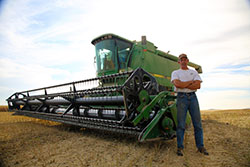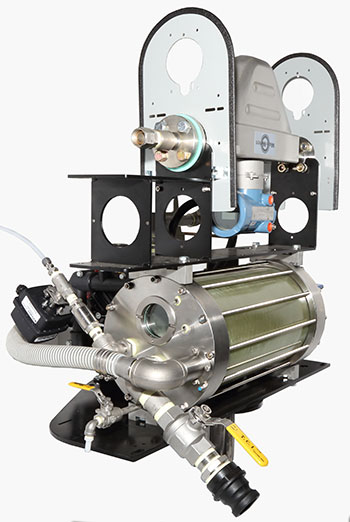|
Colorado, Steve McCasland, Yuma operating a DOT
Transport and delivering to the applicator tank which is a single 2,000.
Pictures on file. Has Approval letter from the State of Colorado.
He was caught by the CHP pulling six, 1,000 gallon ammonia tanks behind a
pickup truck…so he decided to improve his transportation to the field. A
smaller 1,800 acre producer.


In Colorado corn
yields improved because of mounted 2,000 gallon tanks and liquid delivery
of NH3 from a DOT transport...Delivery is made
to side dressing tool bars where trailer nurse tanks will not work
The mounted tank technique made a big difference in producing a 316 bushel
per acre average corn yields in 2012.
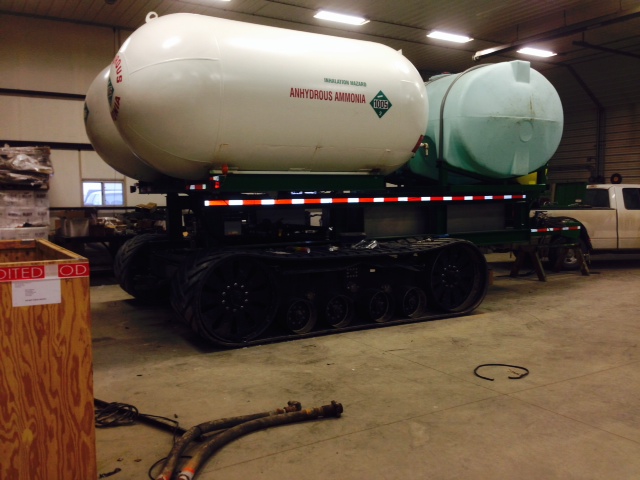
Clay Center, KS.
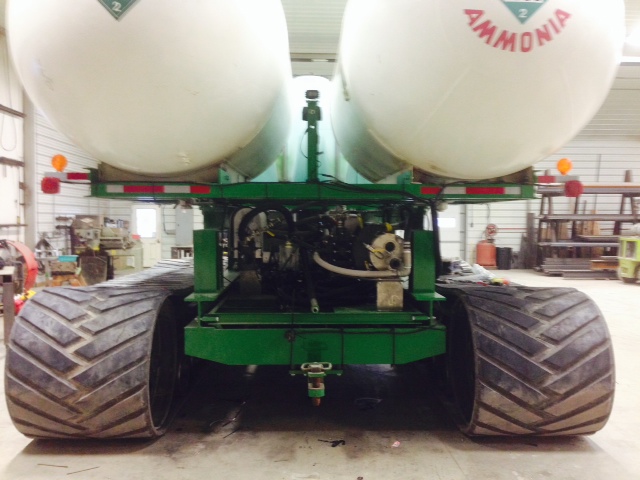
Clay Center, KS.
Kansas allows DOT Transport delivery
to an applicator with a mounted tank. The applicator does not need to have
a MC-330 or MC-331 tank mounted on the applicator. Almost always the total
capacity needs to be 5,000 gallons The applicator does need to be able to
take the delivery of half of the load of the transport or at least 20,000
pounds. The purpose of the Kansas law is political. To protect the
transport drivers and their business whereby they deliver only to large
applicators or storage tanks at farms and dealerships. The transport
drivers will not individual small nurse trailers.
Iowa allows liquid delivery to applicators with mounted tanks and volume
of the tank is limited.
South Dakota allows transport delivery to mounted applicator tanks.

North Dakota has a good safety
record of liquid delivery to the applicator tanks in western ND…several
producers run transports delivering to mounted tanks on Yielder Drills.
Manitoba is the same in sizes of twin tanks mounted in 265 psi rating.

Saskatchewan is the same…mounted tanks
like yours with transport delivery.


Alberta is the same….mounted tanks on the applicator or permanent
trailer..large delivery trucks and large applicators. British Columbia is
the same.


Washington, Ammonia Tanks are often mounted to the tractor in the western
US. This is a very safe way to handle ammonia as proven over 30 years.

Washington, Idaho, Oregon….all tanks
are mounted to the applicator or the tractor or the trailer is
non-detachable.
In the state of Washington….There are no nurse trailers that are towed
down the road since it is unsafe to tow ammonia nurse tanks in the west.

Montana allows transport delivery to
the field...
Utah allows transport and smaller truck delivery to the field.
Texas allows transport delivery to the field as in the state of Washington
because it is safer and keeps the nurse trailers off the road.
The driver is Hazmat approved.
The delivery needs to be made with all the applicable safety equipment.
Liquid delivery is safer for many reasons. Just the efficiency alone makes
it’s safer since it is handled half as much by Hazmat people.
The equipment used with DOT approved transports is much safer.


The 80,000 pound track trailer does not operate at high
speed…it normally operates at field speeds of 8 mph and road speeds seldom
go above 15 mph. the Trailer is not designed to exceed 20 mph.
The 265 PSI tanks that you have installed are safer than
250 psi nurse trailers.
The 265 psi tanks that are in service have safety valve
shutdown and the tanks are heat treated.

The 265 psi rated
tanks and track trailers are set up with ample water for flushing and
showering.
Safety ropes shut down tank valves for transport. Safety ropes are located
at all four corners of the machine.
Highest quality ammonia lines can be used with stainless steel braid
protection.
Jumbo Magnetic filters with the Exactrix Magnetron effect cleans ammonia
for season long performance of the filtration.
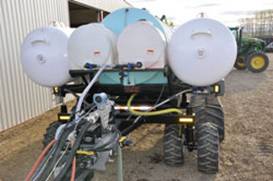

The safety aspect is the power play of Liquid Delivery
of NH3.
To date…all deliveries are safe with no surprises due to advanced
engineering, knowledge and understanding of 60 years of liquid delivery.
In Nebraska conditions we would expect 3 to 4 times less equipment on the
road…with liquid delivery drivers that are Hazmat approved.
Over long distances of 10 miles or greater less plant investment and
service is required. Fewer storage sites and nurse trailer support
stations are required.
In western Nebraska, Liquid Delivery of NH3 is much more competitive than
any other fertilizer source due to the distances involved.
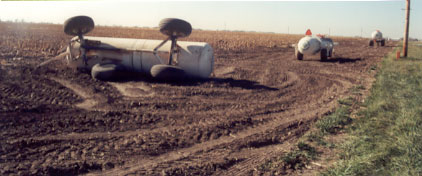
In Nebraska conditions in level land
and especially rolling land north of the Platte River the NH3 nurse
trailers roll over.
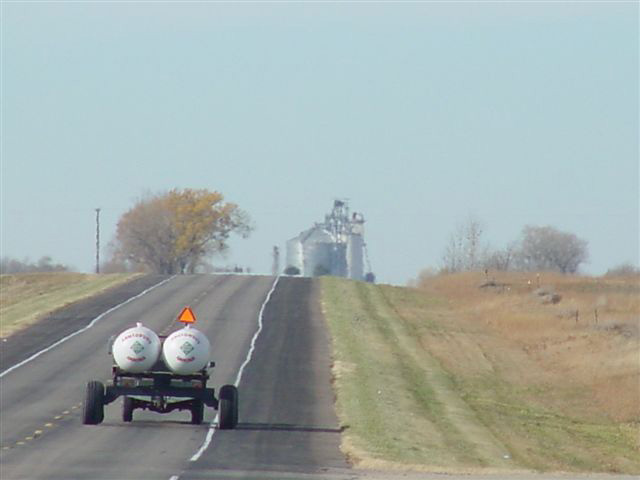
Geneva, Nebraska.
In areas of Nebraska that need to develop higher levels of
efficiency it becomes paramount to make liquid delivery of Anhydrous
Ammonia avoiding nurse trailer tank ammonia over the road.

Alberta Producer…not a fertilizer dealer...a
producer.
For Nebraska Fertilizer dealers a
portion of the investment in NH3 storage has been the nurse trailers. The
nurse trailers…at 1,000 gallons per trailer are 30 to 50 times more likely
to have a ammonia leak or a safety deficiency.
The chances that a 30,000 gallon ammonia tank will have a safety violation
is 30 to 50 times less likely than 30, 1,000 gallon ammonia tanks.
Liquid Delivery is so efficient and so safe as compared to the current
practices. In fact a review of the safe delivery of propane and other
types of gases confirms that nurse trailers are neither practical or safe.
The investment in infrastructure is more viable in the long term. Since
the 30,000 gallon storage tank is not mobile….while the 1,000 gallon
trailer tanks are bouncing around in fields. The wear and tear on pressure
vessel equipment is greatly reduced. It is much easier to inspect and
service one transport tank and two permanently mounted NH3 tanks on the
applicator.


The
disadvantage of Liquid delivery of NH3.
1. Hazmat delivery license required.
2. Higher quality people required to make the delivery.
3. Accepted in Propane..but not understood by farmers and fertilizer
dealers.
4. A Disruptive Business Practice for some fertilizer dealers. Certain
marketing techniques limit the sourcing of ammonia locally and therefore
fertilizer dealers lose control of the their captive market.
5. Fertilizer dealers will want to protect their customer base by
providing their 1,000 gallon trailers.
6. Fertilizer dealers may not have enough capital to participate in the
change to liquid delivery of NH3. They may not have enough capital to move
to a safer system. The capital is available to make the change.
7. Advanced fertilizer dealers want the liquid fertilizer business as well
as the NH3 business. Most producers want to have a competitive stance with
2 or 3 dealers supplying nutrients.

Guy Swanson, Great Plains Reporter for Exactrix Global Systems. |
